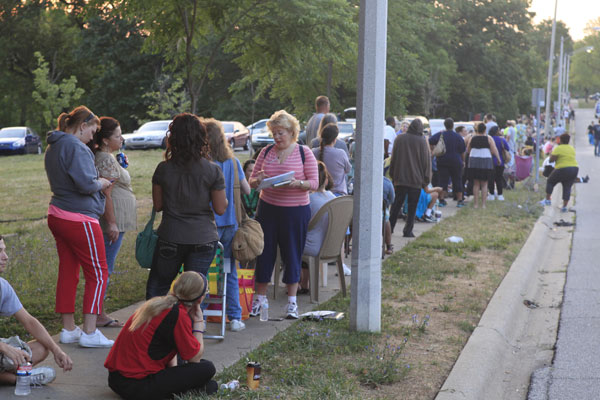What’s Driving High Poverty Numbers?
Rachel Sheffield /

Hundreds wait in line for section 8 housing vouchers in Bloomington, Indiana, in July. (Photo: Polaris)
Today, the U.S. Census Bureau released its annual poverty numbers. It reports that 46.2 million Americans remain poor; the figure was unchanged from last year. The percentage of Americans who were poor remained at a near-record 15 percent.
What we are sure to hear now is a cry from big-government advocates for increased government welfare spending.
But record poverty is not the result of insufficient welfare spending. Last year, the government spent $927 billion on means-tested welfare aid, which breaks down to about $9,000 per lower-income person in the United States. The Census Bureau counts only about 3 percent of this as income when calculating poverty. This flawed measure is a crucial reason why poverty in the U.S. looks very different from the vision most people have of it.
A more accurate way to think of the Census Bureau’s official poverty measure is as a report of “self-sufficiency”: the ability of Americans to sustain an income above poverty without reliance on welfare. The U.S. has record-high poverty (or rather, lack of self-sufficiency) in the short term because of bad policies that have damaged the economy and failed to create jobs. In the long term, the lack of self-sufficiency has been caused by a massive welfare state that discourages work and penalizes marriage.
Welfare policies that support work have a track record of success. The welfare reform of 1996 inserted work requirements for able-bodied individuals into the largest cash-assistance government welfare program. As a result, stagnant welfare rolls began to decline and employment increased.
However, the majority of the roughly 80 welfare programs funded by the government fail to include any type of work requirement. And in July, the Obama Administration issued a directive to gut the 1996 reform law of its work requirement. Taking work out of the equation is in direct contrast to what is necessary to assist those in need. Work requirements should be restored and expanded to other government welfare programs. Food stamps, one of the largest, would be a good place to start.
Marriage is the nation’s greatest weapon against child poverty. As new data reveal, children born to single mothers are nearly six times as likely to be poor than their peers born to married parents. Today’s historically high rate of unwed childbearing—over 40 percent—does not bode well for the economic or overall well-being of children, families, and, ultimately, the nation.
The majority of unwed births in the U.S. are not to teens, as generally thought, but to women in their 20s, and it is a result of the breakdown of marriage in lower-income communities. It is not because these young women (and men) are opposed to marriage, however. In fact, most unwed parents look favorably on the institution.
Tragically, the critical facts about the importance of marriage are rarely if ever communicated to youth at risk for future non-marital births. Most welfare programs, in fact, include marriage penalties. If policies continue to take an indifferent or hostile approach to marriage, high levels of child poverty are bound to continue.
More Americans in poverty—or rather, struggling to attain self-sufficiency—is not good news. Yet if we want to truly improve the lives of these individuals and families, rather than ignoring the causes of poverty, policies should address them. Promoting work and healthy marriages are the most important steps in combating poverty and helping the nation’s families to achieve self-sufficiency.
